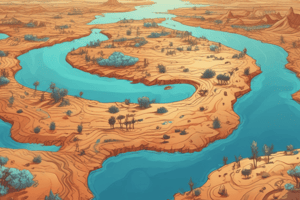Podcast
Questions and Answers
What was the primary cause of conflict regarding the Fairy Creek protests?
What was the primary cause of conflict regarding the Fairy Creek protests?
- Environmental laws established by the federal government
- First Nations support for the logging project
- The logging license granted by the BC government (correct)
- Disagreements among local citizens about trash collection
Which group was directly involved in opposing the logging in Fairy Creek?
Which group was directly involved in opposing the logging in Fairy Creek?
- Local environmental activists alone
- The provincial government officials
- Residents supportive of the logging company
- First Nations communities (correct)
What issue did municipalities face when implementing a limit on garbage collection?
What issue did municipalities face when implementing a limit on garbage collection?
- Conflicts with provincial waste management regulations
- Lack of public awareness about environmental policies
- Public dissatisfaction due to individual waste production disparities (correct)
- Legal disputes regarding waste management contracts
What is a notable aspect of the jurisdictional layers mentioned in the context of environmental planning?
What is a notable aspect of the jurisdictional layers mentioned in the context of environmental planning?
How did the protests at Fairy Creek reflect a larger issue in resource management?
How did the protests at Fairy Creek reflect a larger issue in resource management?
What led to the initial conflict between federal and provincial governments regarding the carbon tax?
What led to the initial conflict between federal and provincial governments regarding the carbon tax?
What is a significant long-term thinking challenge associated with the tragedy of the commons?
What is a significant long-term thinking challenge associated with the tragedy of the commons?
Which scenario exemplifies the uncertainty and complexity challenge in environmental decision-making?
Which scenario exemplifies the uncertainty and complexity challenge in environmental decision-making?
What does co-management primarily focus on in decision-making?
What does co-management primarily focus on in decision-making?
What challenge arises from trying to incorporate long-term thinking into political decision-making?
What challenge arises from trying to incorporate long-term thinking into political decision-making?
What recent socio-economic change affected the housing situation in Waterloo?
What recent socio-economic change affected the housing situation in Waterloo?
In the context of managing resources, what does power-sharing imply within co-management?
In the context of managing resources, what does power-sharing imply within co-management?
How do complex community views contribute to resource management challenges?
How do complex community views contribute to resource management challenges?
What motivated the protests during the War of the Woods?
What motivated the protests during the War of the Woods?
What was the outcome of the Great Bear Rainforest Agreement in terms of land management?
What was the outcome of the Great Bear Rainforest Agreement in terms of land management?
How was grizzly bear hunting initially managed by the BC government?
How was grizzly bear hunting initially managed by the BC government?
What role did indigenous knowledge play in the co-management of grizzly bear habitats?
What role did indigenous knowledge play in the co-management of grizzly bear habitats?
Which of the following statements best describes the relationship between the BC government and First Nations in the management of forestry?
Which of the following statements best describes the relationship between the BC government and First Nations in the management of forestry?
What strategy did environmental activists shift to for greater impact?
What strategy did environmental activists shift to for greater impact?
What was a primary concern related to salmon populations in West Coast fisheries?
What was a primary concern related to salmon populations in West Coast fisheries?
What was the significant focus of the Bear management group formed in 2010?
What was the significant focus of the Bear management group formed in 2010?
What does the term 'co-management' imply in the context of forestry in the Great Bear Rainforest?
What does the term 'co-management' imply in the context of forestry in the Great Bear Rainforest?
What approach is emphasized for managing ecosystems within the Great Bear Rainforest?
What approach is emphasized for managing ecosystems within the Great Bear Rainforest?
What is the primary purpose of environmental assessment in relation to proposed developments?
What is the primary purpose of environmental assessment in relation to proposed developments?
Which act serves as the current framework for environmental assessments in Canada as of 2019?
Which act serves as the current framework for environmental assessments in Canada as of 2019?
What is emphasized in the IAA process regarding early project planning?
What is emphasized in the IAA process regarding early project planning?
Which of the following was a significant change introduced in the IAA compared to previous acts?
Which of the following was a significant change introduced in the IAA compared to previous acts?
What does the IAA require in terms of public involvement in the environmental assessment process?
What does the IAA require in terms of public involvement in the environmental assessment process?
Which concept is highlighted as crucial when assessing environmental impacts under the IAA?
Which concept is highlighted as crucial when assessing environmental impacts under the IAA?
What is a key feature missing from the IAA regarding Indigenous communities?
What is a key feature missing from the IAA regarding Indigenous communities?
Which level of government has the jurisdiction over environmental assessments affecting Indigenous communities?
Which level of government has the jurisdiction over environmental assessments affecting Indigenous communities?
How does minimal regrets planning help in environmental assessments?
How does minimal regrets planning help in environmental assessments?
What aspect of co-management is indicated as lacking in Canada?
What aspect of co-management is indicated as lacking in Canada?
What is a significant concern regarding the environmental impacts of mining?
What is a significant concern regarding the environmental impacts of mining?
How is gangue described in the context of mining?
How is gangue described in the context of mining?
What allows provinces to substitute federal assessments for environmental projects?
What allows provinces to substitute federal assessments for environmental projects?
What was a key reason for the federal government's denial of the Prosperity Mine proposal?
What was a key reason for the federal government's denial of the Prosperity Mine proposal?
What was the main criticism of the provincial assessment for the Prosperity Mine project?
What was the main criticism of the provincial assessment for the Prosperity Mine project?
What was the outcome of the second federal assessment of the Prosperity Mine in 2013?
What was the outcome of the second federal assessment of the Prosperity Mine in 2013?
Why did the mining company propose to create Prosperity Lake?
Why did the mining company propose to create Prosperity Lake?
What key aspect of Chilcotin culture was impacted by the Prosperity Mine project?
What key aspect of Chilcotin culture was impacted by the Prosperity Mine project?
What was indicated by the 2014 Supreme Court ruling regarding the land claim?
What was indicated by the 2014 Supreme Court ruling regarding the land claim?
What essential feature is common in the process of extracting minerals?
What essential feature is common in the process of extracting minerals?
What is a notable characteristic of open-pit mining?
What is a notable characteristic of open-pit mining?
During what year did the environmental assessment process for the Prosperity Mine project begin?
During what year did the environmental assessment process for the Prosperity Mine project begin?
What was an important component of the mining process regarding the metal extraction?
What was an important component of the mining process regarding the metal extraction?
Flashcards
Stakeholder Conflict
Stakeholder Conflict
Disagreements between different groups with differing interests in a project or resource.
Environmental Protest
Environmental Protest
A public demonstration to oppose a development or action, often involving environmental concerns.
Resource Management Conflict
Resource Management Conflict
Disagreements arising from the allocation of natural resources (like land, water).
Government Authority
Government Authority
Signup and view all the flashcards
Citizen Disagreement
Citizen Disagreement
Signup and view all the flashcards
Co-management
Co-management
Signup and view all the flashcards
Tragedy of the Commons
Tragedy of the Commons
Signup and view all the flashcards
Uncertainty and Complexity
Uncertainty and Complexity
Signup and view all the flashcards
Long-term thinking
Long-term thinking
Signup and view all the flashcards
Conflict between Feds and Provincials
Conflict between Feds and Provincials
Signup and view all the flashcards
Short-term impacts
Short-term impacts
Signup and view all the flashcards
Adapting to change
Adapting to change
Signup and view all the flashcards
East Coast Fisheries Collapse
East Coast Fisheries Collapse
Signup and view all the flashcards
Indigenous Knowledge
Indigenous Knowledge
Signup and view all the flashcards
Unceded Territory
Unceded Territory
Signup and view all the flashcards
Ecosystem-based Management
Ecosystem-based Management
Signup and view all the flashcards
Great Bear Rainforest Agreement
Great Bear Rainforest Agreement
Signup and view all the flashcards
Traditional Knowledge in Resource Management
Traditional Knowledge in Resource Management
Signup and view all the flashcards
Grizzly Bear Management
Grizzly Bear Management
Signup and view all the flashcards
Non-invasive Hair Samples
Non-invasive Hair Samples
Signup and view all the flashcards
Food Security
Food Security
Signup and view all the flashcards
Overfishing
Overfishing
Signup and view all the flashcards
Environmental Assessment
Environmental Assessment
Signup and view all the flashcards
Minimal Regrets Planning
Minimal Regrets Planning
Signup and view all the flashcards
Impact Assessment Act (IAA)
Impact Assessment Act (IAA)
Signup and view all the flashcards
Early Dialogue
Early Dialogue
Signup and view all the flashcards
Broadened Scope
Broadened Scope
Signup and view all the flashcards
Project List
Project List
Signup and view all the flashcards
Duty to Consult
Duty to Consult
Signup and view all the flashcards
Science-based Decision Making
Science-based Decision Making
Signup and view all the flashcards
Public Interest
Public Interest
Signup and view all the flashcards
Indigenous Rights
Indigenous Rights
Signup and view all the flashcards
Environmental Assessment (EA)
Environmental Assessment (EA)
Signup and view all the flashcards
Comprehensive Study
Comprehensive Study
Signup and view all the flashcards
Review Panel
Review Panel
Signup and view all the flashcards
Provincial Collaboration and Substitution
Provincial Collaboration and Substitution
Signup and view all the flashcards
Mining Process
Mining Process
Signup and view all the flashcards
Metallic Resources
Metallic Resources
Signup and view all the flashcards
Non-metallic Resources
Non-metallic Resources
Signup and view all the flashcards
Ore
Ore
Signup and view all the flashcards
Gangue
Gangue
Signup and view all the flashcards
Smelting
Smelting
Signup and view all the flashcards
Tailings
Tailings
Signup and view all the flashcards
Open-pit Mining
Open-pit Mining
Signup and view all the flashcards
Fish Lake
Fish Lake
Signup and view all the flashcards
No Net Loss Policy
No Net Loss Policy
Signup and view all the flashcards
Chilcotin First Nation
Chilcotin First Nation
Signup and view all the flashcards
Study Notes
Environmental Planning and Management Challenges
-
Conflict: Often arises between different entities (e.g., different levels of government, First Nations, industry) and stakeholders in project development, resource management, and environmental protection. Example: Fairy Creek, BC logging protests illustrate conflict between resource companies, First Nations, and citizens. Difficulties can stem from resource management disagreements, jurisdictional conflicts between federal, provincial, and municipal levels of government, changing societal views, and differing perspectives on government authority and the role of each level.
-
Uncertainty and Complexity: Understanding ecological systems is complex and incomplete, leading to challenges in anticipating the impacts of environmental planning and management decisions.
-
Long-Term Thinking: The "tragedy of commons" concept, where overexploitation of shared resources occurs, often demonstrates a lack of consideration for long-term sustainability. Short-term gains may come at a cost to long-term ecological health and societal well-being, as seen in the collapse of the East Coast fisheries in 1992. This calls for policies and strategies that prioritize long-term environmental outcomes over short-term gains.
-
Adapting to Change: Rapid socioeconomic changes, such as the Covid-19 pandemic, affect environmental planning decisions. Predicting future impacts and developing adaptability is crucial to anticipate and address changing circumstances (e.g. the housing crisis in Waterloo following the pandemic).
Co-Management Approach
- Definition: An approach to shared resource management between government entities, Indigenous communities, and other stakeholders is utilized globally. It is an ongoing, iterative decision-making process rather than a static state.
- Key Elements: Co-management integrates the use of resources, partnerships between governing entities and other vested parties, and dynamic decision-making processes. This involves acknowledging the diversity of perspectives and values held by different participants.
- Complexity: Implementing co-management strategies is complex due to differing views, diverse levels of governmental authority, and varying indigenous knowledge systems. The legitimate authority of actors involved and the backing of legislation can differ considerably.
- Example: Great Bear Rainforest: Co-management efforts within the rainforest demonstrate various successes and complexities. It emphasized a shift from adversarial to collaborative approaches for resource management and protection of indigenous rights. The province maintained jurisdictional authority, but co-management principles led to significant changes in how specific resources (e.g., logging, grizzly bear hunting, and fishing) were managed in the ecosystem. The process involved a complex interplay of indigenous knowledge, scientific data, and conventional legal systems.
Environmental Assessment
- Purpose: Environmental assessments identify, predict, and evaluate the potential impact of projects. The aim is to inform decision-making and mitigate negative impacts where possible. For example, considering an alternative road route or constructing wildlife overpasses.
- Legal Frameworks: The Canadian Environmental Assessment Act (1995) & Impact Assessment Act (2019) outline legal and regulatory processes governing environmental assessments.
- Process (Impact Assessment Act): Early stakeholder dialogue, broadened scope of assessments that incorporate Indigenous rights and broader environmental factors, public consultation, and a review panel contribute to the decision-making process.
- Provincial Collaboration vs. Federal Substitution: The federal government can work with provincial jurisdictions, or delegate assessments to them, streamlining processes.
The Mining Process
- Categories of Resources: Mining resources include metallic (e.g., copper), non-metallic (e.g., salt), and energy (e.g., fossil fuels), which are often extracted through open-pit or subsurface methods.
- Processing Metals: Metal extraction involves identifying, removing the metal of interest (e.g., copper) from ore which often includes separating it from waste rock identified as gangue. The remaining waste (gangue) is often managed in tailing ponds.
- Environmental Impacts: Mining activities can have impacts such as surface runoff, underground contamination, and disruption of ecosystems. Tailing ponds are significant sources of potential contamination.
Case Study: Prosperity Mine
- Context: The Prosperity Mine project in Chilcotin Traditional Territory is a controversial example of environmental assessment and co-management challenges.
- Challenges: The project involves Indigenous rights, environmental impact, and economic considerations. Initial assessments raised significant issues related to fish habitats, Indigenous heritage sites, and potential cumulative impacts on grizzly bears. The involvement of multiple levels of government and stakeholders and differing views on the project caused extensive conflict.
- Outcome: The project faced extensive legal and political challenges and was ultimately abandoned due to various factors, including extensive court battles and the expiry of approvals. This case illustrates the complexities of reconciling economic development, environmental protection, and Indigenous rights within the context of environmental assessment.
Studying That Suits You
Use AI to generate personalized quizzes and flashcards to suit your learning preferences.




